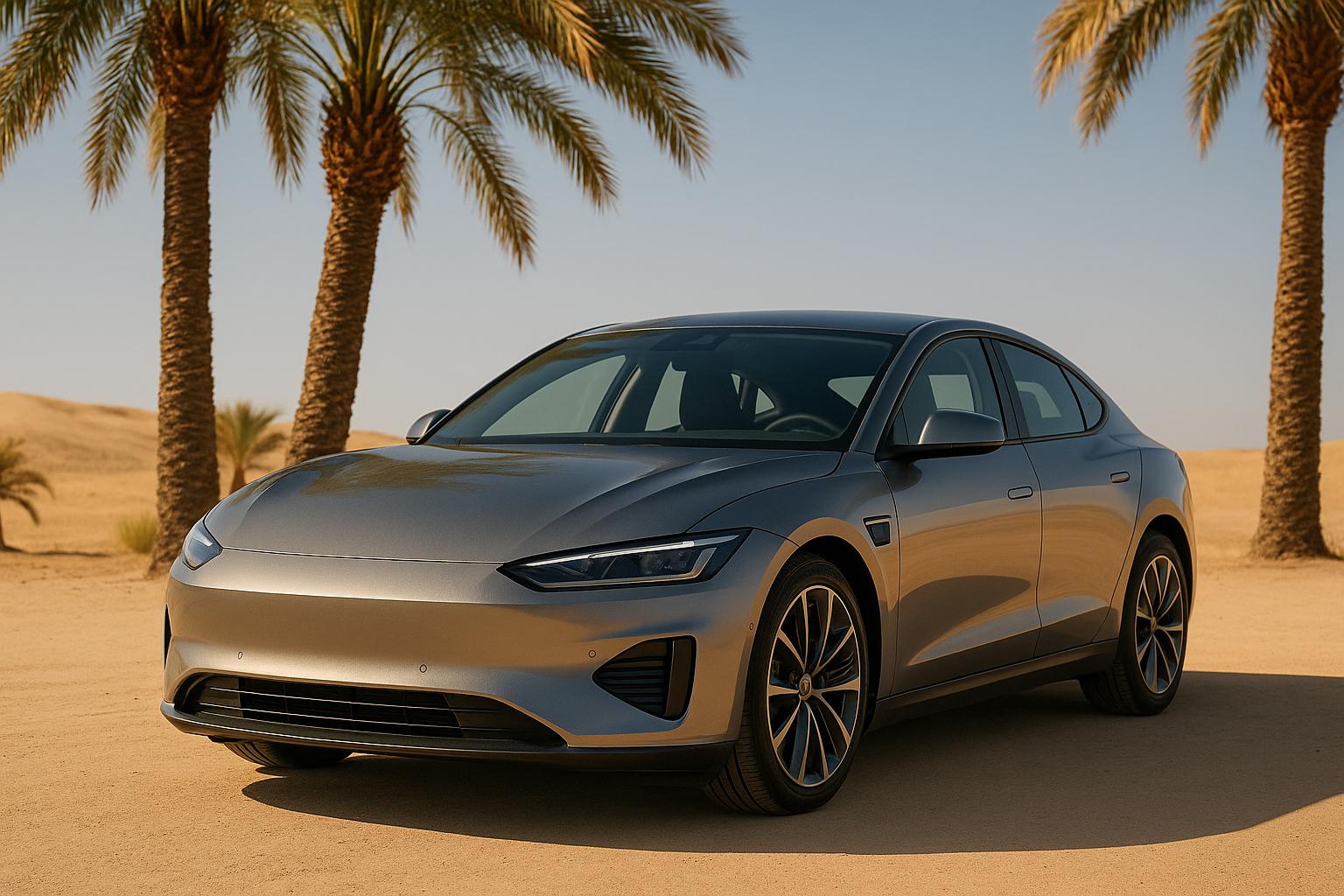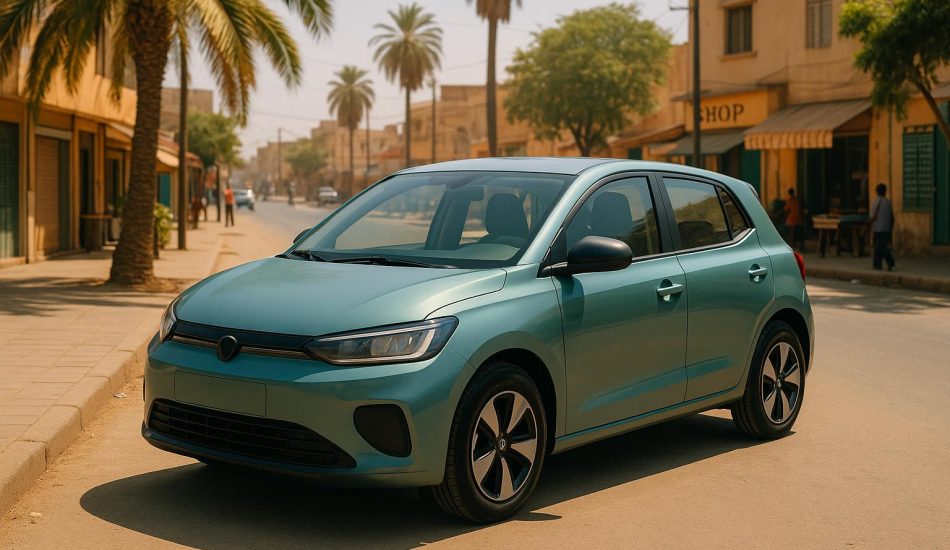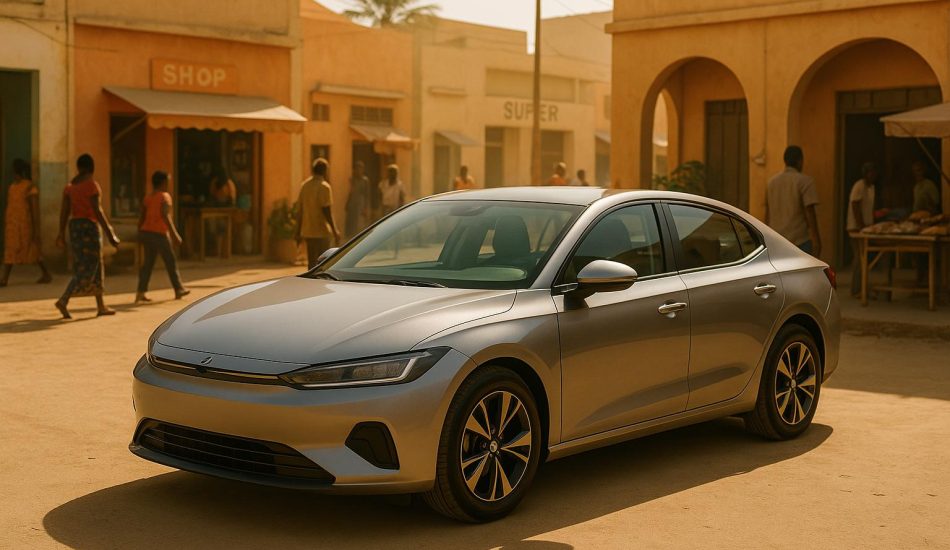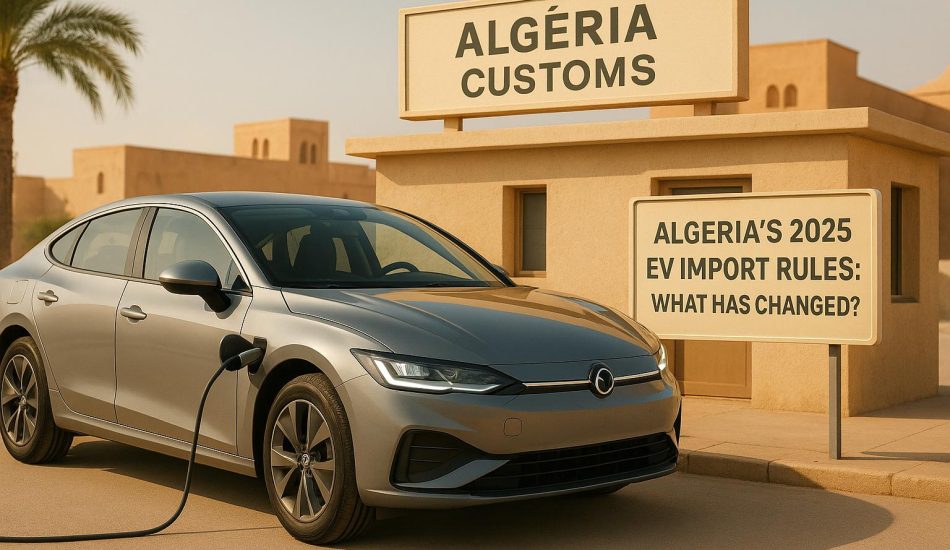
When temperatures rise above 90°F, your EV’s battery and performance can take a hit. Heat affects range, increases energy use, and accelerates battery wear. But with smart strategies, you can protect your EV and maintain efficiency.
Key Tips to Keep Your EV Cool:
- Park in Shade or Use Sun Protection: Avoid direct sunlight to prevent heat buildup. Use sunshades, window covers, or legal tinting to lower cabin temperatures.
- Precondition While Plugged In: Cool your EV and battery using grid power before driving to save energy and improve performance.
- Manage Air Conditioning Smartly: Use moderate A/C settings, recirculation mode, and alternative cooling methods like ventilated seats to conserve range.
- Limit Fast Charging in Heat: Avoid frequent DC fast charging, especially in high temperatures, to reduce battery stress and degradation.
- Reduce Load & Plan Routes: Lighten your vehicle, avoid stop-and-go traffic, and drive smoothly to minimize heat generation.
Why It Matters:
High heat can reduce range by up to 18%, increase energy use by 25-28%, and accelerate battery aging. These simple steps help you protect your EV, extend battery life, and stay efficient in hot weather.
Best Tips to Maximize EV Battery Life In Hot Weather. How Hot Weather Affects Your EV Range.
1. Park in Shade or Use Sun Protection
Keeping your EV out of direct sunlight is a simple yet effective way to prevent heat buildup. On a sunny day, the interior of a car parked in direct sunlight can heat up by as much as 40°F in just an hour, while vehicles parked in the shade typically experience only about a 20°F increase. Lower interior temperatures help protect your EV’s battery, reducing the risk of heat-related degradation, especially when temperatures exceed 86°F.
Use Covered Parking Areas
Whenever possible, opt for covered parking – whether it’s a garage, carport, or even natural shade from trees or buildings. This reduces heat buildup and eases the strain on your EV’s battery management system.
"Drivers should be mindful about parking in the shade, especially during the hottest hours of the day, or park up inside a garage", advises Tim Alcock from LeaseElectricCar.co.uk.
"Overheating the EV battery while parked in hot sunshine for a long time will degrade a battery. And with the car switched off there is no battery management system running to keep it cool", explains Peter Devon from Speak EV.
If covered parking isn’t an option, consider using external sun protection to minimize heat exposure.
Install Sunshades and Window Covers
When shade isn’t available, sunshades and window covers can be a great alternative. These simple tools can lower cabin temperatures by up to 27°F (15°C) and reduce surface temperatures inside the car by 20–27°F (11–15°C). Custom-fit sunshades offer the best coverage and are available at various price points to suit different budgets. Always place the reflective side outward for maximum heat deflection.
For EVs with large glass roofs, like the Tesla Model Y, specialized roof sunshades or heat shields are particularly important. These not only protect sensitive electronics but also help reduce excessive heat buildup.
Consider Legal Window Tinting
If you’re looking for a more permanent solution, window tinting is worth considering. High-quality ceramic or nano-ceramic tints can block over 99% of harmful UV rays and reduce heat penetration by more than 60%. This can also ease the load on your air conditioning system, which, if overused, can cut an EV’s range by 10–15%.
When choosing a tint, go for ceramic or carbon-based films, as metallic tints may interfere with your car’s sensitive systems. Professional ceramic tinting typically costs between $400 and $1,000. Before proceeding, check your local Visible Light Transmission (VLT) regulations to ensure compliance. After installation, give the film about a week to cure and clean it only with ammonia-free products and a microfiber cloth to maintain its quality.
2. Use Preconditioning While Plugged In
Preconditioning is a handy feature in modern EVs, particularly during hot weather. It allows you to cool your vehicle’s cabin and battery before hitting the road, using power from the grid instead of draining your car’s battery. This not only helps preserve your driving range but also ensures a more comfortable ride. When your EV is plugged into a charger, preconditioning uses the external power source to cool the cabin to your desired temperature.
This system also optimizes your battery’s temperature, keeping it in the ideal range of 59°F to 95°F (15°C to 35°C) for peak performance. Many EVs are equipped with built-in heating and cooling systems designed for this purpose, ensuring your car is ready to perform efficiently as soon as you start driving.
"Put simply, preconditioning allows you to pre-heat or pre-cool the car’s cabin before you start your journey. Not only will you feel more comfortable, you will maximize your EV’s driving range and prolong the life of its battery", says the Motoring Electric team.
What is Preconditioning?
Preconditioning takes care of cooling or heating tasks while your EV is still plugged into an external power source. This means your cabin is already at a comfortable temperature, and your battery is primed for efficient operation when you begin your drive.
In hot climates, this feature is especially useful. It spares your air conditioning system from overworking to cool down a hot cabin during the first few minutes of driving. Instead, the A/C can focus on maintaining a steady temperature, saving energy and improving efficiency.
"When the EV is plugged in during preconditioning, energy is drawn from the power source, not the battery itself. This means the driving range remains unaffected, and the battery is optimized for fast, efficient charging from the start", explains Kia.
Schedule Cooling with Mobile Apps
Technology makes preconditioning even easier. Most modern EVs come with smartphone apps or in-car scheduling systems that let you automate the process. With these tools, you can set up preconditioning to match your daily routine without needing to activate it manually each time.
Using your EV’s app or onboard system, you can schedule preconditioning to start at specific times. The vehicle calculates when to begin the process based on your departure time, ensuring your cabin and battery are ready when you are. If you have overlapping schedules, the system intelligently adjusts to maximize efficiency.
Benefits of Preconditioning in Hot Weather
Preconditioning offers several advantages, especially during the summer months. It helps preserve your driving range, protects your battery’s health, and ensures a comfortable cabin – all without taxing the battery.
The most noticeable benefit is range preservation. Since preconditioning uses grid electricity, you begin your trip with a fully charged battery and a pre-cooled cabin. This reduces the strain on your vehicle’s systems and improves overall efficiency.
It’s also a win for battery health. Extreme heat can wear down battery cells over time, but preconditioning helps keep the battery within its ideal temperature range of 59°F to 95°F. By reducing thermal stress, you can extend the lifespan of your EV’s battery.
For vehicles equipped with heat pumps, preconditioning becomes even more efficient. These systems can repurpose waste heat from battery conditioning to cool the cabin, lowering energy consumption during your drive. This coordination between battery and cabin cooling ensures a more energy-efficient ride.
While preconditioning works best when your EV is plugged in, it can also run on battery power if needed – provided the vehicle isn’t in Low Power Mode. To get the most out of this feature, make preconditioning a regular part of your charging routine, especially during the hottest months of the year.
3. Manage Air Conditioning and Cabin Cooling
After using smart preconditioning, managing your cabin cooling is the next step to conserve battery power in your EV. Your air conditioning (A/C) system can be a significant energy drain, but with a few smart strategies, you can keep your cabin comfortable without sacrificing too much range. Here’s how to make the most of your A/C system.
When your car’s interior hits 95°F after baking in the sun, the A/C might need 3–5 kilowatts (kW) of energy to bring it down to a comfortable level. Once the target temperature is reached, maintaining it generally requires around 1 kW of power [40,10,46].
"Running the air conditioning at full blast will quickly reduce your car’s driving range. Use the AC, but set a moderate temperature."
Set Moderate A/C Temperatures
Instead of blasting your A/C at its lowest setting, aim for a moderate temperature that balances comfort and energy efficiency. For instance, on a 100°F day, setting your cabin to 78–80°F is a practical choice. This approach, often called the "20-degree rule", suggests keeping your car’s interior no more than 20°F cooler than the outside temperature. By doing this, you can significantly reduce energy usage. For example, at 95°F, running your A/C could lower your EV’s range by about 17% [41,42,46]. The higher the outside temperature, the more noticeable the impact on your range.
Once your car reaches the desired temperature, the cooling system works more efficiently. As one expert notes:
"A car’s HVAC system has to get from dangerously hot or cold to comfortable in a very short period of time and then it winds up running at only a fraction of its full capacity most of the time."
- KennyBSAT
Use Recirculation Mode
Recirculation mode is a great way to boost A/C efficiency. Instead of pulling in hot air from outside, it recirculates the already-cooled air inside the cabin. On a day where temperatures hover around 86°F, using recirculation mode can add up to 16 extra miles to your driving range and improve heat pump efficiency by as much as 38%.
This mode also reduces the strain on key A/C components like the blower and compressor, which can help extend their lifespan. Plus, it minimizes the entry of outside pollutants, cutting pollutant levels by about 20% in heavy traffic [50,51]. For best results, if your car has been sitting in direct sunlight and feels excessively hot, crack the windows briefly to let out the trapped heat before switching to recirculation mode [51,53].
Try Alternative Cooling Methods
Your A/C doesn’t have to handle all the cooling on its own. Ventilated seats, available in many modern EVs, can provide direct cooling while using less energy than cooling the entire cabin. Some vehicles also offer cooling features for the seats and steering wheel, which target the areas you’re in direct contact with, allowing you to stay comfortable even if the cabin temperature is slightly higher.
sbb-itb-99e19e3
4. Limit Fast Charging in Extreme Heat
Fast charging in high temperatures can take a toll on your EV battery. When the mercury rises above 85°F, the battery’s internal chemistry starts to break down, and fast charging only accelerates this process.
Nick Zamanov, an EV infrastructure expert at CyberSwitching, puts it bluntly:
"Heat is one of the most silent threats to EV battery health."
During fast charging, the heat generated can push the battery’s temperature beyond safe levels unless the cooling system is working overtime .
Avoid Frequent Fast Charging
Think of fast charging like sprinting – it gets the job done quickly but comes at a cost. Overusing fast charging, especially in hot weather, can lead to issues like lithium plating and Solid Electrolyte Interphase (SEI) growth. These are technical terms for processes that permanently reduce your battery’s ability to hold and deliver energy.
Research backs this up. Geotab found a clear connection between high temperatures, frequent fast charging, and faster battery wear. For example, a study comparing two Nissan Leafs revealed that using DC rapid charging exclusively led to 16% more battery degradation compared to standard AC charging. While newer Tesla models haven’t yet shown significant differences in degradation, researchers caution that the effects might show up later as these batteries age.
The takeaway? Use DC fast charging sparingly – save it for road trips or emergencies, especially in hot weather. For daily charging, stick to Level 2 AC chargers at home or work. They’re much easier on your battery and give the thermal system time to manage heat effectively. You can also reduce heat stress by charging during cooler parts of the day.
Charge During Cooler Times
Timing matters when it comes to charging. Early mornings or late evenings are ideal since lithium-ion batteries work best between 68°F and 77°F. Charging during the heat of the day – say, when it’s 100°F – forces the battery’s thermal management system to work harder, and in some cases, it might even pause charging until conditions improve. Public chargers may also reduce their power output or temporarily shut down during extreme heat.
Charging during off-peak hours has another perk – it can lower your electricity bill.
Once you’ve adjusted your charging habits, it’s also important to keep an eye on your battery’s temperature.
Monitor Battery Temperature
Your EV’s thermal management system is designed to keep the battery in its sweet spot – between 68°F and 86°F – for optimal performance and lifespan . Unlike traditional car engines that can handle temperatures up to 210°F, EV batteries require much tighter temperature control.
If your battery is already hot from driving in warm weather, let it cool down before plugging into a fast charger. Pay attention to signs that the thermal management system might be struggling, like slower charging speeds, reduced power output, or interrupted charging sessions.
Modern EVs are equipped with advanced thermal management systems that use predictive algorithms to maintain battery temperatures within ±2°C of the ideal range. These systems can reduce energy use by 15-25% compared to older designs and keep temperature variations between cells minimal.
If you plan to keep your EV for years to come, treat fast charging as a tool for special situations. Avoid it when your battery is already hot, extremely cold, or near extreme charge levels (like 5% or 90%). These conditions put extra strain on the battery and its management system, speeding up wear and tear.
5. Reduce Vehicle Load and Plan Efficient Routes
Your EV has to work harder when carrying extra weight or navigating through stop-and-go traffic. This added effort generates more heat, putting extra strain on your cooling system. The battery’s energy demand directly impacts heat production, a phenomenon known as Joule heating, where higher current draw leads to increased thermal stress.
By lightening your EV’s load and planning routes more thoughtfully, you can ease energy demands, reduce heat generation, and protect your battery’s health. Let’s explore some practical ways to achieve this.
Lighten the Load
Extra weight makes your EV’s battery and motors work harder, especially in hot weather. The heat generated by the battery increases exponentially with higher current draw – so even a small bump in power demand can lead to a significant rise in heat.
Start by decluttering your vehicle. Clear out unnecessary items from the trunk, back seat, and storage areas. If you don’t absolutely need that rooftop cargo box, leave it behind – it not only adds weight but also increases aerodynamic drag, making your EV work harder.
The difference is particularly noticeable when driving uphill or accelerating. A lighter vehicle requires less current from the battery, which means less heat and less strain on your cooling system. This helps maintain the battery’s optimal temperature range of 59°F to 95°F, even on warmer days.
Plan Routes to Avoid Traffic
Stop-and-go traffic is a nightmare for your EV’s heat management. Constant acceleration and braking force the battery to supply frequent bursts of high current, generating unnecessary heat that strains the cooling system.
Combine multiple errands into one trip to cut down on traffic-heavy, energy-draining drives. This is especially important on hot days when the battery is already dealing with high ambient temperatures. Use your EV’s built-in navigation or specialized apps to find the most efficient routes.
For example, Google Maps EV Routing, available in vehicles like the Ford Mustang Mach-E and F-150 Lightning, suggests charging stops and can even precondition your battery when approaching a DC fast charger. These features help you avoid routes that could overwork your EV and direct you to cooler charging locations, such as covered parking garages.
Whenever possible, aim for routes with steady traffic flow. Highways are often more efficient than city streets with frequent stops, even if they’re slightly longer. Maintaining a consistent speed reduces the current spikes that generate excess heat, giving your cooling system a break.
Adopt Efficient Driving Habits
Your driving style plays a big role in how much heat your EV produces. Smooth, gradual driving reduces current spikes, helping to keep your battery and motors cool. Here’s how you can drive smarter:
- Accelerate and brake gently: Sudden acceleration demands maximum current from the battery, creating heat surges. Instead, build speed gradually and anticipate traffic to avoid unnecessary stops.
- Maximize regenerative braking: Lift off the accelerator early when slowing down to convert kinetic energy back into electricity, reducing heat buildup from traditional braking. Many EVs let you adjust regen braking levels – experiment with higher settings to recover more energy.
- Use Eco mode: Activating your EV’s Eco mode automatically reduces energy use by limiting acceleration power, capping top speeds, and optimizing other systems. While you might sacrifice some performance, this significantly cuts down on heat generation, which is crucial in hot weather.
Chris Hardy, Senior Advice Editor at Kelley Blue Book, notes, "Smart driving and the use of eco mode will help reduce energy consumption and optimize efficiency so that you get the most out of your vehicle in the heat".
Other tips include maintaining steady speeds with cruise control on highways when traffic allows. Research shows that sticking to the speed limit helps conserve range and minimizes heat buildup.
Lastly, don’t overlook tire pressure. Underinflated tires increase rolling resistance, forcing the battery to work harder and generate more heat. Check your tire pressure regularly – when the tires are cold – and keep them inflated to the manufacturer’s recommended PSI.
Conclusion
Keeping your EV cool in hot climates is essential for protecting the battery and extending the overall lifespan of your vehicle. Simple strategies like parking in the shade, preconditioning the cabin, using the air conditioning efficiently, and being mindful of fast charging can help maintain the battery within its ideal temperature range. These measures are particularly important because an EV’s range can drop significantly once temperatures exceed safe levels.
Beyond comfort, these practices play a crucial role in preserving battery health. Failing to follow them can lead to faster battery degradation and even the risk of thermal runaway during extreme heat. Studies show that exposure to temperatures above 80°F for more than five days a year can speed up degradation. In severe cases, extreme heat – ranging from 158°F to 212°F (70°C to 100°C) – can cause thermal runaway, permanently damaging the battery pack . Early EV models, like the 2011 Nissan Leaf, which relied on passive cooling, often suffered from premature battery failures in hot regions such as Arizona and Nevada, where parking lot temperatures could hit 140°F (60°C) or higher .
Thankfully, most modern EVs now come equipped with advanced liquid-cooling thermal management systems that are far more effective than the older air-cooled designs. However, even with these improvements, smart driving and parking habits remain key to optimizing performance.
If you’re looking for an EV that’s specifically designed to handle hot climates, EV24.africa offers a wide selection of modern models from brands like Tesla, BYD, Hyundai, and Toyota. These vehicles come with cutting-edge thermal management systems that are built for challenging conditions. EV24.africa also provides delivery across 54 African countries, along with expert advice to help you maintain and care for your EV, ensuring it performs efficiently for years to come.
FAQs
Why does parking in the shade or using sun protection help protect an EV battery in hot weather?
Keeping your electric vehicle (EV) parked in the shade or using sun protection can go a long way in protecting its battery. High temperatures can speed up battery degradation, ultimately shortening its lifespan. By keeping your car cooler, you not only reduce the strain on the battery but also lower the energy demand for cooling systems, which can help improve overall efficiency.
Limiting prolonged exposure to heat also reduces thermal stress on the battery, helping it perform more reliably over time. Simple actions like using a windshield sunshade or choosing a shaded parking spot can make a noticeable difference in maintaining your EV’s battery health during those hot summer days.
What are the advantages of preconditioning an EV while it’s plugged in, and how is it different from using the air conditioning after starting your drive?
Preconditioning your EV while it’s still plugged in can make a noticeable difference in both comfort and performance. By using external power to heat or cool the cabin and battery before hitting the road, you’re not just ensuring a more pleasant ride – you’re also helping to maintain your vehicle’s battery range. This feature becomes especially handy in extreme weather, as it saves the battery from working overtime to regulate temperatures during your drive.
Here’s the key advantage: preconditioning uses shore power instead of drawing energy directly from the battery. So, while your car is getting ready, your battery stays fully charged and ready to deliver maximum range. It’s an easy, effective way to boost efficiency and make your EV experience smoother, whether it’s freezing cold or blazing hot outside.
Why should you avoid fast charging your EV in extreme heat, and how does it affect the battery’s lifespan?
Fast charging your EV in scorching temperatures can place additional stress on the battery, accelerating its wear and tear. When high heat combines with the rapid energy flow from fast charging, the battery’s temperature can spike further. This increased heat can lead to chemical imbalances and a quicker decline in battery capacity over time.
To help preserve your EV’s battery and keep it running longer, try to avoid fast charging during very hot weather. Instead, stick to standard charging methods, as they produce less heat and are much easier on the battery in extreme conditions.




